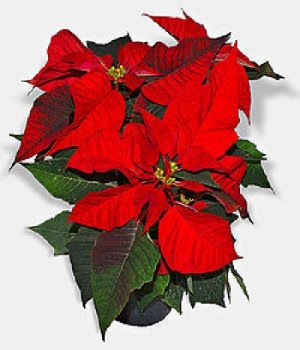
|
 December 10, 2008 December 10, 2008 
Homage to the Christmas Star
The Aztecs called poinsettias "Cuetlaxochitl", the literal meaning of which is "the flower with leather petals". From the 14th to the 16th centuries they used the sap to control fevers, and the colorful bracts (modified leaves) to make a red dye. The Aztecs believed all flowers were divine gifts from the gods.
This star-shaped, red, winter-flowering plant was a special favorite and was considered by the ancient Mexicans to be a symbol of the new life earned by the warriors who died in battle. "As hummingbirds and butterflies, these warriors would return to earth to sip the nectar of the Poinsettia."
Montezuma had poinsettias brought into what now is Mexico City because poinsettias could not be grown in its high altitude. After Cortes's arrival and subsequent conquest of the Aztecs, Franciscan religious brought poinsettias into the churches at Christmas nativity processions, the first recorded use of the flowers at a holiday. So began a new tradition.
|
A German botanist, Wilenow, gave it the botanical name, Euphorbia pulcherrima, "pulcherrima" from the Latin, meaning "very beautiful."
The poinsettia, AKA the "Christmas Star", is also known as the "Flower of the Holy Night" (Flor de Noche Buena). From southern Mexico comes a charming legend about it origin. One Christmas Eve very long ago, a poor young boy came to his village church with no gift to bring to the Christ child and he was very sad. He didn't feel worthy to enter the church so he knelt outside the door and prayed assuring God of his fervent love of the Babe in spite of his being poor and empty handed. A green plant with beautiful red blossoms grew at his feet. Breaking some of the flowers from the plant, the boy proudly entered the church and laid his gift at the Christ child's feet. The legend says that since that first appearance the plant has spread all over the land.
|

Seventy-five percent of all poinsettias produced are red, a nod to the traditional favorite color choice.
|
President John Q. Adams in the 1820's appointed Joel Roberts Poinsett as the first United States Ambassador to Mexico. Because of his interest in botany, during a stay in Mexico, he wandered the countryside looking for new plant species. In 1828 he found one with a beautiful display of red color. He took cuttings from the plant, brought them back to his greenhouse in South Carolina. William Prescott, a historian and horticulturist, named the plant the poinsettia in honor of Joel Poinsett's discovery.
In the early 1900's the Ecke family of southern California grew poinsettias outdoors for use as landscape plants and as a cut flower. From 1923 to the mid-1960s, the Paul Ecke Family Ranch of Encinitas, California, produced field grown poinsettias as a Christmas flower, shipped them all over the country, but found they were not particularly adaptable to greenhouse growing.
Then, in 1963, Paul Ecke, Jr. with formal training in horticulture changed everything. He convinced his father to change to greenhouse cultivation. This was accompanied by the newest developments in breeding cultivars best suited for growing in potted plants and, a special secret. Soon, the Ecke family held a virtual monopoly on poinsettia production, all thanks to a technological breakthrough to which competitors had no knowledge. The Ecke technique involved grafting two different varieties together that resulted in a fuller, bushier plant, very suitable to potted culture. Eventually the family grew poinsettias in greenhouses and today it is recognized as the leading producer of poinsettias in the United States.
Then in the mid-1990s, a university researcher discovered the method and published it. Now the technique became known worldwide and growers around the globe began employing it to great success. A dream of Paul Ecke Sr.'s was fulfilled: to introduce to our nation the first potted poinsettia and create a new holiday tradition. The poinsettia is still the number one selling potted plant, with 70 to 80 million selling each holiday season ($ 240 million annually). There are currently more than 120 commercial varieties available.
Did you know that the poinsettia has a special day all its own? By an Act of Congress, December 12 was set aside as National Poinsettia Day. The date marks the death of Joel Roberts Poinsett, who is credited with introducing the native Mexican plant to the United States. The purpose of the day is to enjoy the beauty of this popular holiday plant. The poinsettia only blooms during short days (long nights).
The American Society of Florists says no other consumer plant has been tested for toxicity more than the poinsettia. The belief in poinsettia poison extends back to 1919 when the two-year-old child of a U.S. Army officer died. It was believed that the child died from ingesting poinsettia leaves. This myth persisted until 1975 when it was finally put to rest after years of extensive scientific tests and studies.
If you want to bring home a plant that truly exemplifies the joy of the holiday season, there are currently more than 175 patented varieties from which to choose, including Cranberry Punch, Champagne, and Nutcracker Pink among some of the newer ones
I'd rather have roses on my table than diamonds on my neck.
- Emma Goldman
From
The Garden of Ed. Submitted for publication in The Towne Crier on
December 10, 2008
Also for The Sullivan County Democrat "Gift Guide" on December 5, 2008
© 2008 Ed Mues. All Rights Reserved.

eMail:
eGarden@MountainAir.us

|

|

